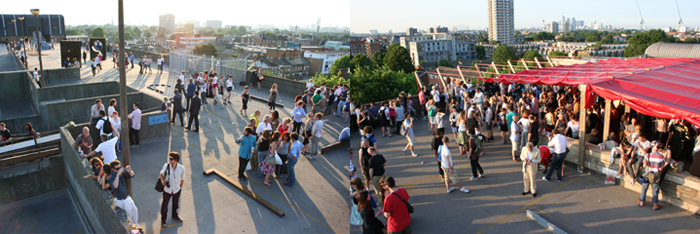
"Bold Tendencies" opening in Peckham (author not pictured)
I don’t understand why anyone would like Elizabeth Peyton, but I also don’t understand why anyone would like egg whites or Coldplay or The Shawshank Redemption, so maybe I’ll never understand. Her first UK solo show at the Whitechapel Art Gallery is so fey and self-conscious that I had to crush a can of Bud against my forehead and punch the wall out of sheer repressed masculine frustration. The drive to the police station and subsequent waiting around for my lawyer gave me sufficient time to mull over Peyton’s work. If I did like her work, what might I say about it? That its intimate scale and willful prettification of some of the nineties’ butt-ugliest pop stars brings together teenage fandom and the tradition of 18th-century portraiture? That its objectification of sallow Caucasian male beauty strikes a blow for the female gaze? That the breathless swishiness of her paintbrush and contre-jour light effects create poignant elegies to the transience of youth? That Peyton’s reimagining of Delacroix as the drummer in The Strokes and Napoleon as a Lower East Side DJ is somehow a radical reinterpretation of history? In Peyton’s words, Napoleon was “a beautiful man and he had a big vision about life.” Ever seen Elizabeth Peyton and Sasha Baron Cohen in the same room together?
Meanwhile, at Camden Arts Centre, Johanna Billing’s absorbing and beautiful film works – on TV screens, large projections, and portable DVD players – generate an effortless intimacy that looks willfully dumb in Peyton’s work. Her latest film, I’m Lost Without Your Rhythm (2009), follows a group of Romanian dancers and musicians rehearsing in a big drafty mansion, whose trust falls and neck rolls are spliced among images of walking, tripping, cleaning, bicycling so that everything becomes a kind of dance of interconnected bodies. Billing’s sense of accidental beauty grows out of the participants’ relaxation in front of the camera, rather than – as in so much nominally participative art – the participants guilelessly enacting the artist’s themes. It’s hard not to draw parallels with Antony Gormley’s current One and Other project in Trafalgar Square, in which participants, inaudibly elevated above the crowds, are subsumed to self-congratulatory political and artistic ends. Billing’s ongoing You Don’t Love Me Yet project (started in 2002) asks musicians, of all levels, ages, and nationalities, to perform a little-known 1984 Roky Erickson song (because most of Roky Erickson’s mid-eighties songs are really well-known). The results, each on a separate DVD scattered across a table in the main gallery space, can be watched individually on little DVD players, which feels appropriate. Each has the shambolic, intimate, DIY feel of a self-released covers album produced by a small town rock band. Repetition and ham-fisted musicianship renders the plaintive lyrics (“To be or not to be/That’s the question unceasingly”) into a kind of mad football chant of slacker celebration.
Thanks to the New York Times, my area of London has transformed itself into a mecca of cappuccino bars and organic delis, so to get the rough-around-the-edges feel a contemporary art fan like myself thrives on, I need to decamp to somewhere less gentrified. Hannah Barry Gallery is currently staging a group show of contemporary sculpture, entitled Bold Tendencies, on the top level of a multi-story car park in the heart of Peckham, an area of London often euphemistically described as “edgy.” Guest projects by roving curatorial and gallery projects (The Sunday Painter, New Model Army, Field, and Lucky PDF) occupy some of the vast windblown lower levels, whose huge apertures fill the spaces with light and give onto the broken-tooth skyline of central London. Delicate film and slide projections on cracked concrete piloti play out a lo-fi unfussiness that would seem precious if it weren’t for the overarching spirit of generosity that the whole thing generates (a series of Tweets documents the whole thing here). A take-off of Barnett Newman’s Broken Obelisk from MoMA’s atrium – a plywood obelisk whose apex, broken off, wobbles on a spring from the fractured base – is an assertion of relative institutional impotency like something out of Bruno. It might be the Negronis talking (there’s an excellent Campari bar on the top level), but the Peckham installation feels like an exit strategy for an art world in the throes of insecurity.




Pingback: Has Elizabeth Peyton-bashing become a sub-genre of art criticism? : Bad at Sports
Pingback: Letter from London: Peyton for Godot | Ryan Fitzer